Climbing requires a completely different technique than cycling in a flat country. There, all energy is used to overcome air resistance, and to a much lesser extent rolling resistance. But in the mountains the energy is used to lift your weight. Air and rolling resistance hardly play a role anymore.
The steeper the slope, the more difficult it is. After all, you have to overcome more elevation meters in one kilometer.
Weight
The weight of the bicycle, rider and luggage is crucial. That is why we always insist on limiting the weight. This applies to the bicycle, the luggage and the rider. If you make sure you lose some excess pounds before you leave for the Hundred Cols, you have a better chance of a successful Hundred Cols Tour. It is often much easier to lose some pounds yourself than to make the bicycle lighter. But it certainly makes sense to aim for weight reduction in all three categories. You can pay extra attention to the weight of the bicycle when purchasing parts. A new saddle, a luggage carrier, wheels, tires, the pump, these are all things that are available in many different weight (and price) classes.
You must also limit the weight of your luggage. That starts with the bags, which are sometimes disproportionately heavy. So pay attention to the weight when purchasing. With the rest of the luggage, you can limit the stuff you take with you, but also its weight. So look critically at all the things that go into the bags. With each thing, ask yourself whether it is really necessary, and if so, whether it could be done a little lighter. You can take a heavy Goretex rain jacket of 450 grams, but also a lightweight jacket of 130 grams. You can take a pair of regular shoes and jeans for the evening, but also slippers and light summer pants or thin training pants.
Condition
It is difficult to climb if you are in poor condition. Climbing requires a lot of effort, especially in the high mountains. The energy consumption is much greater than in flat rides, and the body is not yet used to it in the beginning. It is wise to train well in advance, for example by taking longer rides and at a slightly higher pace than you are used to. This way you can improve your fitness a little more before the big work starts. Then don't make the stages too long in the beginning, but build up gradually. Take sufficient rest, especially during those first rides. If you are used to stopping for a cup of coffee only after 60 km, do that much earlier in the mountains. Also make sure you eat enough, because you use a lot of energy. Don't underestimate the energy consumption in a long climb! Even if you have been to the bakery extensively in Laruns, it is not certain that you will reach the top of the Aubisque. Therefore, always make sure you have food with you in a form that you can easily eat. Rice porridge, bananas or energy drinks are very suitable.
Pace
If you climb, ride at a conservative pace. Remember that a climb can be very long (there are ascents up to 25 km), and that there will be more climbs that day and the following days. It is top sport every day in the Hundred Cols. Drive slowly, at a pace that you are sure you can maintain all the way to the top. Drive a little slower in the steep sections, rather than exerting more energy to maintain your pace.
When it is hot, it is important not to climb too fast, because you will blow yourself up. But climbing too slowly is also not fun, because you have very little wind and therefore hardly cool down.
If you ride with a heart rate monitor, it can be very helpful in limiting your pace. In any case, make sure you never drive in the red area, but don't let the heart rate monitor determine your pace completely. Don't forget that in the meantime you should also just enjoy cycling, the surroundings, and the ultimate performance you are delivering.
Technique
Climbing is preferably done while sitting in the saddle. Climbing upright can help to overcome a short, steep passage, for example in a bend. But you can't manage to climb an entire Alpine pass while standing. When climbing while standing, the heart rate increases, as has been scientifically shown. Breathing also increases, like the muscle activity of the upper legs. Therefore, try to climb in the saddle as much as possible.
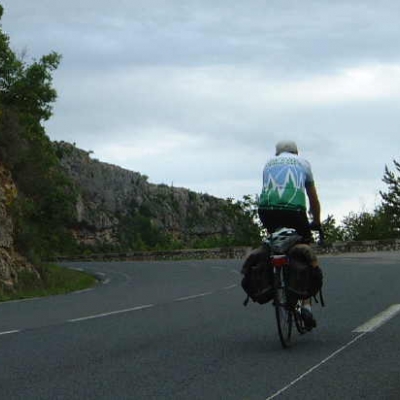
You can occasionally get out of the saddle to relieve some of the strain on your back. Climbing while standing is sometimes unavoidable in very steep passages, because even with the slightest gearing the pedaling speed becomes so slow that it is no longer possible to do it while sitting. Try to keep pedaling calmly, even when standing, and not to move your body too much. The upper body must be moved gently from left to right to get the weight properly over the proper leg. Don't whip too much, that takes way too much useless energy.
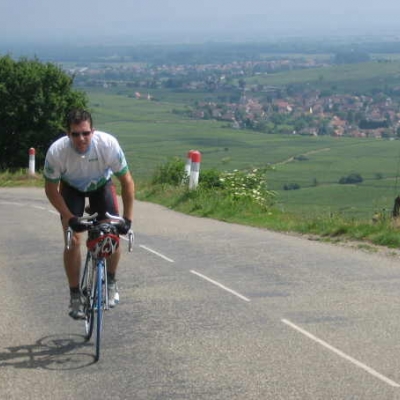
When climbing, it is also useful not only to push on the pedals, but to pull with the other foot too. This way you can distribute the forces over both legs and the maximum required force is somewhat less. This also prevents the risk of acidification or cramps. Climbing involves intense effort and therefore very active breathing. This is not easy when the lungs are compressed by a very stooped position. That position is not necessary, because the speed is low, and aerodynamics therefore hardly play a role. It is much easier to grip the handlebars at the brake levers or on top of the steer tube.
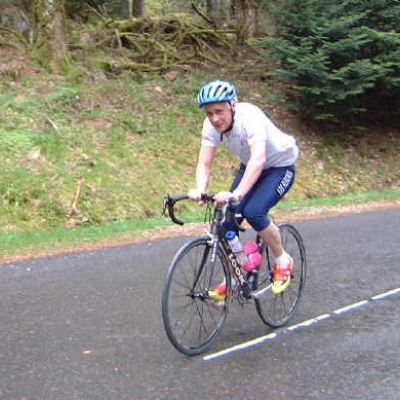
In climbs that alternate steep parts with short flat sections or descents, such as the Grand Colombier, Croix de la Serra, Bellefontaine or the Grand Ballon, it is important to continue to supply energy in those sections. It is rather tempting to keep your legs still there. You may recover a bit, but then it is difficult to suddenly start climbing again. Better to keep a good pace on those parts by continuing to pedal.
There are indications that a slightly lower saddle position is more efficient in the mountains. However, be careful with experiments in the Hundred Cols Tour. It is not inconceivable that you will experience joint problems if the bicycle is adjusted, such as in the ankles, knees and hips. If you think that a different adjustment would be advantageous in the mountains, do so well in advance and drive several kilometers in flatter areas nearby before heading into the mountains.
Gear shifting
Always choose the lightest possible gear that matches the climbing pace. A light resistance, and therefore a higher pedaling rhythm, is easier to maintain than heavy pedaling. A light resistance is also much more efficient, as scientific research has shown. An additional advantage is that you are less likely to sustain injuries, have less chance of cramps, and can also last much longer. And that is really necessary during a Hundred Cols, because you almost never have an easy day.
It is difficult to shift gears at a low pedaling rhythm. So rememberto downshift in time when you encounter a steep passage. If you think, "If I push hard, I'll make it with this resistance," you could be wrong and you'll fall silent after a while. Switching back has now become impossible. So never let the pedaling pace become too slow.
The minimum cadence is about sixty. If you fall below that, you should, if possible, switch to a lighter gear or drive faster.
Descending seems easy. You no longer have to pedal, your posture is hardly important, you only have to steer and brake occasionally. But in practice it is not that simple. Below are some tips.
Keep pedaling
Altahough it is not really necessary, on gentle descents it is nice to give the bike a little speed during the descent. In those cases you can pedal with advantage, which of course involves heavy gearing. You often see gears of 53x11 or even heavier, but that is of little use to you as a sporty cyclist. Even with 52x13 you can get down just fine, and certainly not much later than with a very heavy gearing. When choosing your gear, pay more attention to the large sprockets than to the small ones, because finding the right cadence on the climb is much more critical than on the descent. You can always get down, but going up is a lot more difficult! Be careful when pedaling in (hairpin) bends, because you run the risk of the pedals hitting the road, which often results in a serious fall. You only pedal in a bend when you have almost gone through it, the bike is pointing in the right direction, and you sit upright again.
Attitude
Aerodynamics do play a role in the descent, because the speed is high. By sitting deep, with your hands at the bottom of the handlebars, you can increase the speed. You can reduce your speed by sitting more upright. Lift your seat slightly from the saddle. This means that you reduce the pressure on the saddle and increase that on the handlebars and pedals. Because these points are lower than the saddle, stability is increased. You must keep the point of the saddle between your legs, otherwise you will no longer be able to steer properly.
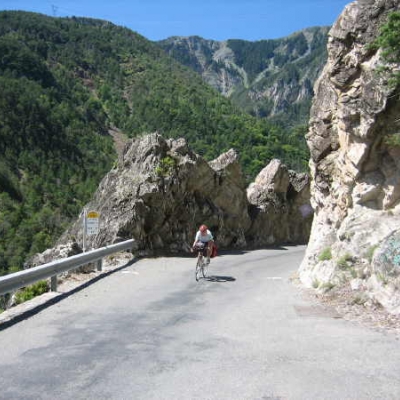
Bends and brakes
The bends are dangerous on the descent. Downhill falls occur almost exclusively in bends. The most common cause is braking too late or not strongly enough, or with the wrong technique. In the straight sections you can let the bike run smoothly, and the speed can increase considerably on steep sections. It is important that you correctly estimate the steepness of the road, because it - with the speed - determines the length of the braking distance. Make sure you do not let the speed increase too high, so that you can brake in time for a bend. Use the front brake almost exclusively. Because you have to brake sharply for a bend, your full weight is on the front wheel. In very steep sections the rear wheel can even come loose from the ground. It is clear that the rear brake cannot do much in such a situation. It will quickly make you slip. Because braking always happens in a bend, the rear wheel slips easily.
If the road is clear, you can sit up before the bend to slow down, then drive to the side of the road where you can look down (if it is on the left, watch out for overtaking fast traffic!), so that you can have a good view of the road section after the bend. Then you know what to expect when you enter the bend (oncoming traffic!). Brake with the front brake as long as you are not yet in the bend, because if you have to brake too much in the bend, you can easily crash.
In the bend you must continue to brake lightly, otherwise the speed will increase again while you have not yet completed the bend.
Take the bend as wide as possible, without ending up on the other side of the road. So you take a left turn by riding on the far right, then steering inwards along the center line, and letting the bike go again after the bend. As soon as you are sitting upright again, you can also start pedaling to regain the lost speed. During the bend, hold the pedal on the side of the bend up and keep your knee slightly bent outwards. Maintain sufficient pressure on the other downward-facing pedal so that the bicycle remains more stable.
Shimmy
Shimmy is the phenomenon that the bicycle suddenly starts to sway during a descent and becomes difficult to control. This is the case when the bicycle comes into resonance with the wheel rotation. For the technicians: the bicycle is a feedback system, which obtains its stability through the high degree of negative feedback. A movement to the left is corrected by steering to the right. But if the frame or wheels are weak and the damping is poor, the bicycle can come into resonance. It occurs at one specific speed. You can get out of it by either cycling faster or slower. So braking is the wisest thing to do. Because the rider is also part of the feedback system, you can influence the resonance frequency by changing your position. Grip the handlebars less convulsively (although that is an unnatural reaction when shimmy occurs...), rise from the saddle and keep your legs against the top tube. That can give the bicycle a lot more stability.
Clothing
You don't need much clothing when climbing, because your body keeps itself warm. It's amazing to see how you can sometimes cycle up in the snow in shorts and short sleeves, but as soon as you get to the top you completely cool down within twenty seconds. So make sure you have easy access to your winter clothes in those situations so you can put them on quickly.
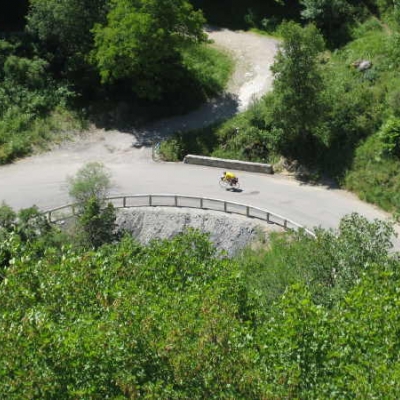
Descending in freezing rain happens quite often, and you have to be dressed for it. In any case, make sure you have real gloves, because it is difficult to brake with numb hands. Long cycling shorts that are not too thick without chamois or loose leg warmers are sufficient to protect the legs. A summer jacket under the rain jacket is also sufficient, and for the cold, a headband or hat can be very pleasant. Such a strap does not weigh much, and there is not much point in saving on that weight.
It goes without saying that you wear a helmet during the descent. When you fall, you fall hard, and when you dive into the abyss you have no control over your fall. So wear a good helmet. This is not very necessary when climbing, and it only bothers you when it is hot. Make a good provision to easily hang it on the bicycle without it bothering you.